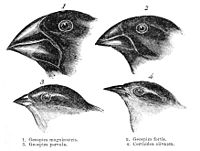
Photo from wikipedia
Divergence is often ephemeral, and populations that diverge in response to regional topographic and climatic factors may not remain reproductively isolated when they come into secondary contact. We investigated the… Click to show full abstract
Divergence is often ephemeral, and populations that diverge in response to regional topographic and climatic factors may not remain reproductively isolated when they come into secondary contact. We investigated the geographic structure and evolutionary history of population divergence within Sceloporus occidentalis (Western Fence Lizards), a habitat generalist with a broad distribution that spans the major biogeographic regions of Western North America. We used double digest RAD sequencing to infer population structure, phylogeny, and demography. Population genetic structure is hierarchical and geographically structured with evidence for gene flow between biogeographic regions. Consistent with the isolation-expansion model of divergence during Quaternary glacial-interglacial cycles, gene flow and secondary contact are supported as important processes explaining the demographic histories of populations. Although populations may have diverged as they spread northward in a ring-like manner around the Sierra Nevada and southern Cascade Ranges, there is strong evidence for gene flow among populations at the northern terminus of the ring. We propose the concept of an "ephemeral ring species" and contrast S. occidentalis with the classic North American ring species, Ensatina eschscholtzii. Contrary to expectations of lower genetic diversity at northern latitudes following post-Quaternary-glaciation expansion, the ephemeral nature of divergence in S. occidentalis has produced centers of high genetic diversity for different reasons in the south (long-term stability) versus the north (secondary contact).
Journal Title: Molecular ecology
Year Published: 2021
Link to full text (if available)
Share on Social Media: Sign Up to like & get
recommendations!